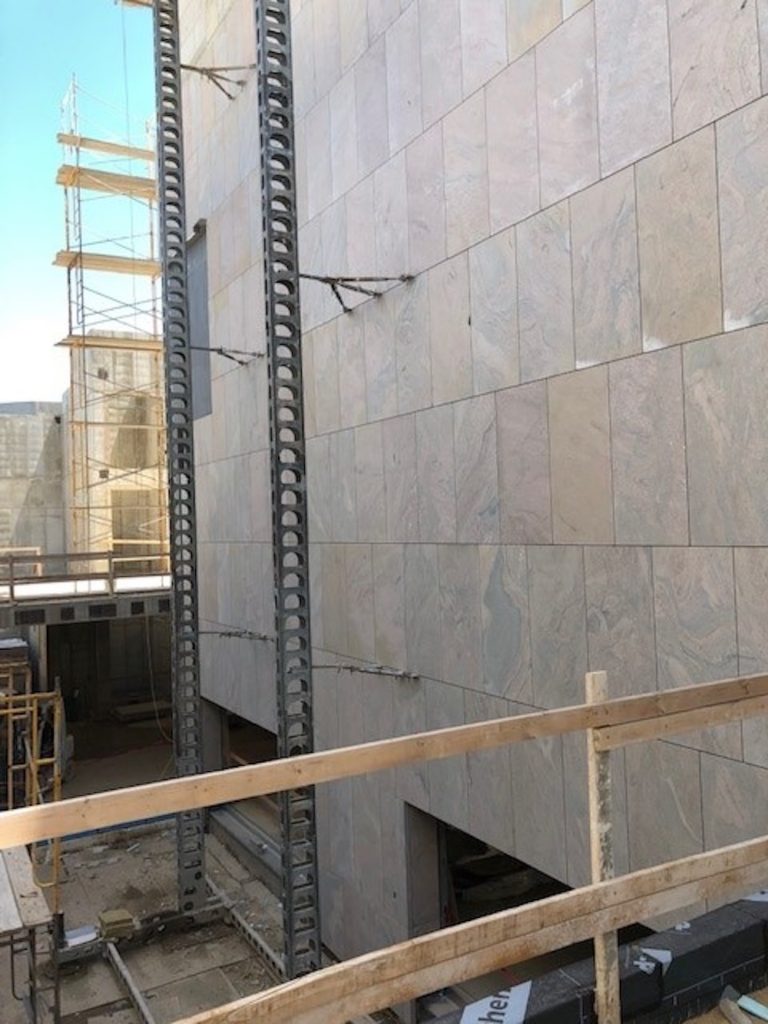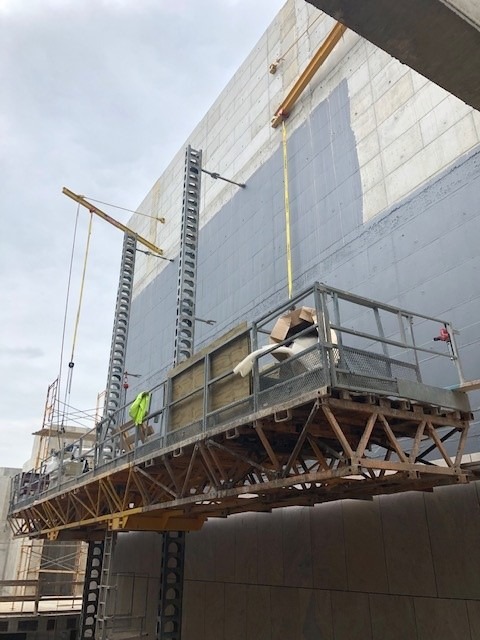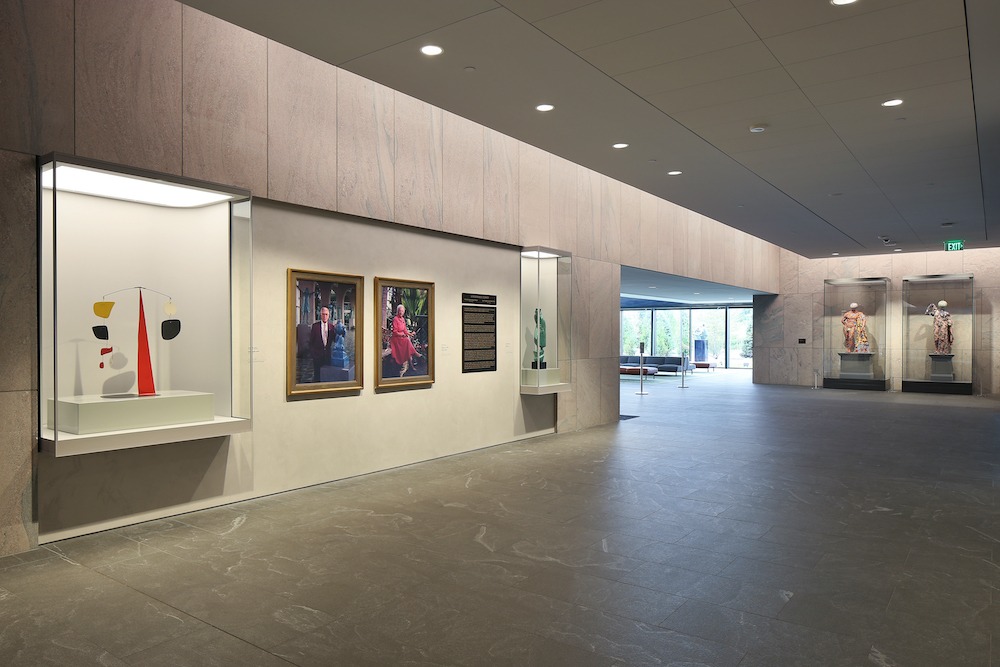Granite Plays Key Role in Challenging Gardens Upgrade
Words: Jason Kron
Large pieces, specific color requirements create beautiful new spaces at Michigan’s Frederik Meijer Gardens
Words: Jason Kron, Director of Sales
Photos: JK Masonry, David Sparks Photography
Grand Rapids, Michigan, is home to one of the nation’s premier sculpture and botanical gardens – Frederik Meijer Gardens. In 2017, Meijer Gardens announced plans for a $115-million expansion, including a new 69,000-square-foot Welcome Center and upgrades to their Amphitheater.
Natural stone played a key role in meeting the design vision, including more than 71,000 square feet of Echo Lake granite from Coldspring® 's Orr, MN., the quarry was specified for various exterior and interior design areas.
According to the design team of Tod Williams Billie Tsien Architects of New York, project goals included tying together the many parts of the Garden into a coherent and understandable whole and creating a Welcome Center that amazed everyone who entered.
Requirements included a durable, cost-effective, and timeless material that felt warm in tone and natural to its location. As one of the most durable and beautiful surfaces on the planet, granite was the ideal choice for Meijer Gardens. Capable of withstanding weather and human interaction elements, granite excels in all types of situations due to its hardness and resistance to wear. With low-maintenance and minimal upkeep, granite structures built more than half a century ago remain standing as a testament to its resilience and natural sustainability.

What’s more, a stone with the visual appeal of life and movement was a must, as the architect wanted visitors to see a different building in the morning than in the afternoon. Echo Lake granite -- a warm beige-colored granite with numerous sporadic, dark black markings and subtle accents of rose — was the perfect choice to achieve the architect’s vision. It was used in the Amphitheater for benches and in the Welcome Center for the exterior and interior facing, roof coping, Welcome Center information desk, ramp and wall facing, and stair guardrails.
Before the design team made the final decision on the granite selection, they visited the Echo Lake quarry in Orr, Minn. Visiting the quarry can help designers better visualize the project, and in this case, the visit also assured the team the Echo Lake quarry was a viable source for providing the large quantities required.
Coldspring provided a large-scale mockup to demonstrate the panels in various finishes during the quarry visit. Different finishes can create a variety of shades and tones and strikingly different looks making the mock-up important to determine the best finish for Frederick Meijer Gardens.
In the end, a Diamond 5® finish was selected for most of the project pieces, such as exterior and interior facing, roof coping, amphitheater benches, ramp and wall facing, and stair guardrails. The Diamond 5 finish provides a non-reflective, smooth appearance with subtle contrasts and highlights to bring out the stone’s colors.

Polish finish was selected for the Welcome Center’s information desk. This highly reflective, smooth finish magnifies the stone’s natural appearance and illuminates vibrant colors.
Quarrying Techniques
“The architects had very specific requirements for the allowable color range, markings, and inclusions for the granite, which we were able to provide,” says Ken Hogan, Regional Sales Manager, Coldspring.
Modern quarrying techniques allowed the stone provider to access the exact pieces of stone to meet the architect’s requirements. But this wasn’t always a straightforward process. Stone quarries were open-shaft and serviced by stiff leg-lifting derricks for many years. Most of the work was performed with manual labor, while light machinery was used for lifting.
Quarrying involved freeing single blocks, sized for lifting and distance from the derrick. Derricks had to be moved to various locations, and quarriers were required to move deeper or open new holes adjacent to the original deposit. As equipment and techniques advanced, this method of quarrying became more difficult.

Modern quarries such as the Echo Lake quarry utilize “drive-in” functionality. Mobile equipment for cutting, extracting, lifting, and hauling stone can access all levels of quarry strata, or “benches.” This allows various parts of the quarry to be accessed for the size of the stone, color variations, or other considerations.
Capacity can easily be increased by adding mobile equipment and crews to meet demand. During extraction, Coldspring’s experienced quarry team did an excellent job chasing the desirable black markings and not allowing unwanted markings in the product to achieve the designer’s vision.
The diamond wire saw is another modern quarry innovation that facilitated the architect’s design goals with the stone. The diamond wire saw opens up and develops various areas of the quarry. It can cut vertically and horizontally and is also useful as a portable trimming tool for specific sizes and thicknesses. This flexible tool replaced several previous operations, like explosives and jet burners that are now obsolete.
Fabrication
Fabrication of the granite pieces for Meijer Gardens included modern manufacturing techniques to achieve the project’s goals. Many of the panels for the Welcome Center were extremely large rectilinear pieces – measuring 2’8” by 9’4” to 10’10”. As a building material supplier with the capacity and ability to quarry and fabricate granite in the large-scale quantities required for the project, Coldspring expertly handled the large pieces moving through the plant.

Generally speaking, only certain stone manufacturing facilities are built to handle large piece sizes and can craft such dimensions to meet the designer’s vision. Natural stone fabrication is a highly evolved, technically advanced process to turn a rough slab into a finished product. The fabrication process involves meeting and/or completing the following:
- Thickness standards
- Slabbing operations
- Slab finishing methods
- Cut-to-size process
- CNC (Computer Numerically Controlled) production
- Inspection and shipping
Installation
The large pieces required special anchors and relief angles for installation, with type 31 anchors on the back. In addition, minimizing joints for the large piece sizes was a requirement in the stone detailing. An exceptionally skilled installation contractor, JK Masonry of Grand Rapids, Mich., handled the unique requirements and large, heavy 2-inch-thick piece sizes.
“For the 70-foot-tall walls of the Welcome Center, our team used a series of wall cranes mounted to the wall and bolted on with trolleys,” says Corey Knauf of JK Masonry. “Every elevation had its own set of challenges. To set the granite along the roof, we followed Coldspring’s advice on using clamps to set the stone.”

The stone supplier’s collaboration at every phase of the project -- from the onset with the design team to the installation and completion – was vital to its success. Granite provided a beautiful material to ground and defined the landscape at Meijer Gardens. When the architect fell in love with a particular stone, the challenging work began among the team to meet the project’s high expectations.
Meijer Gardens hosts 750,000 visitors each year by the stunning new Welcome Center. The Amphitheater is a distinguished venue for entertainment events throughout the year, with brilliant acoustics and tiered lawn seating for 1,900 guests. These most recent upgrades have turned Meijer Gardens into a top cultural destination in the Midwest. They have given it a reputation internationally for the quality of its art and gardens. Meijer Gardens continues serving an expanding audience with the vision of connecting the community, land, and the arts.